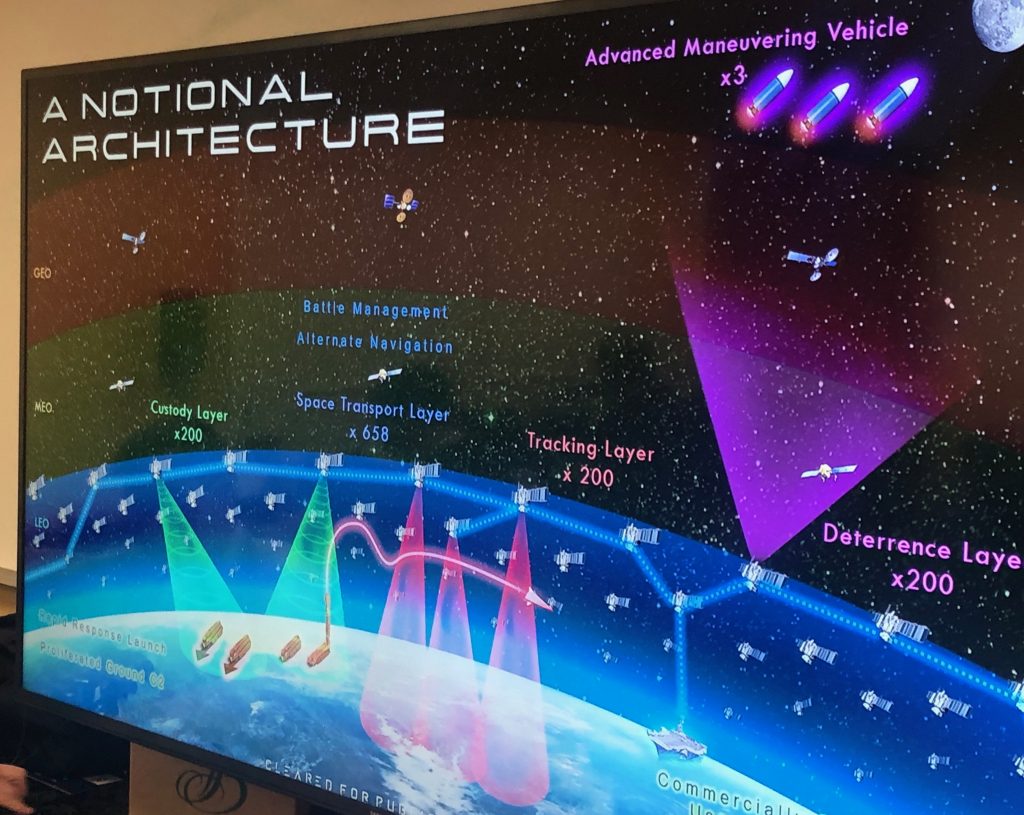At its first industry day July 23, the Space Development Agency (SDA) likely will focus on only a small subset of capabilities included in its “Next-Generation Architecture” request for information (RFI) — reflecting the more limited approach of Pentagon Research and Engineering chief Mike Griffin to develop constellations of small satellites in Low Earth Orbit (LEO).

Insiders and industry observers say that Griffin scrapped the idea of moving out rapidly to solicit commercial capabilities across the architecture’s seven mission layers. Instead, Griffin wants to prioritize what he has described from the beginning as SDA’s primary focus: using LEO-based smallsats for advanced missile tracking including hypersonics, and for creating a so-called Space Transport Layer.
The SDA’s July 1 RFI explains the Space Transport Layer as follows: “Global, persistent, low-latency data and communications proliferated ‘mesh’ network to provide 24×7 global communications.”
Acting SDA Director Derek Tournear (who is double-hatted as the director of space under Griffin) is further expected to take a slow, careful approach to so-called ‘proliferated LEO’ that starts with small experiments, sources say.
Griffin is not a huge believer in the commercial potential for large constellations of LEO satellites (‘proliferated LEO’ in space jargon), insiders say, and would rather harvest commercial technology for ingestion into more traditional-style DoD acquisition programs. Indeed, his more cautious, one-step-at-a-time attitude toward SDA’s mission was one of the key reasons for the abrupt (and somewhat acrimonious) resignation of the first SDA Director Fred Kennedy after only four months on the job.
“Griffin’s disagreement with Kennedy was more about how, not what,” said one former DoD space official.
The RFI explains that SDA is looking to potential contractors to supply “concepts for rapid prototyping, risk-reduction efforts that could be demonstrated in less than 18 months” that link to its proposed architecture, such as:
- Low-cost, low-SWaP (Size, Weight and Power) optical communication payload for high-bandwidth, space-to-space intersatellite links (ISL)
- Algorithms to support tracking of advanced missile threats from LEO;
- Algorithms to facilitate autonomous on-board space sensor tasking, collection, processing, and dissemination, and
- Alternative forms of Position, Navigation and Timing (aka GPS).
Griffin’s stated priorities for SDA have long been focused on missile defense. Griffin also oversees the Missile Defense Agency (MDA), and his involvement in missile defense work dates back to President Ronald Reagan’s ‘Star Wars’ program.
SDA’s RFI directs interested vendors to SDA’s ‘notional architecture’ as the basis of their submissions, which was the result of a 60-day study headed by Kennedy. Kennedy revealed the architecture (that included satellites in cislunar space) at the 2019 Space Symposium in April. However, sources say the RFI has been in the works for a while, and likely was released now in order for Griffin and Acting Air Force Secretary Matthew Donovan to prove to a highly skeptical Congress that there is a coherent plan for SDA’s future.
“This was already well into the works before the recent kerfuffle,” the former DoD official said.
“What else is SDA supposed to do?” asked another DoD insider. “And this is just an RFI…”